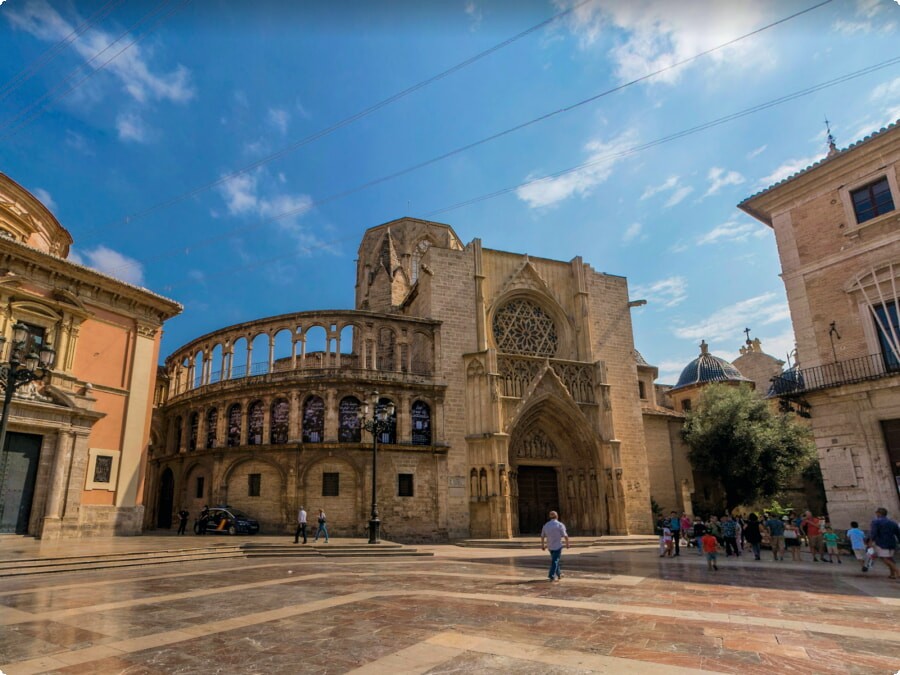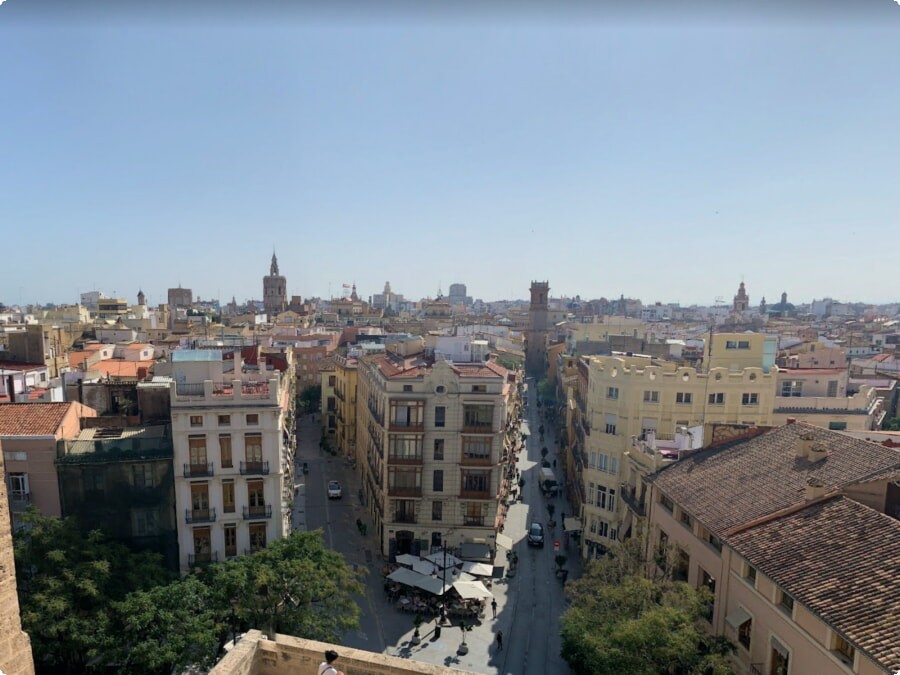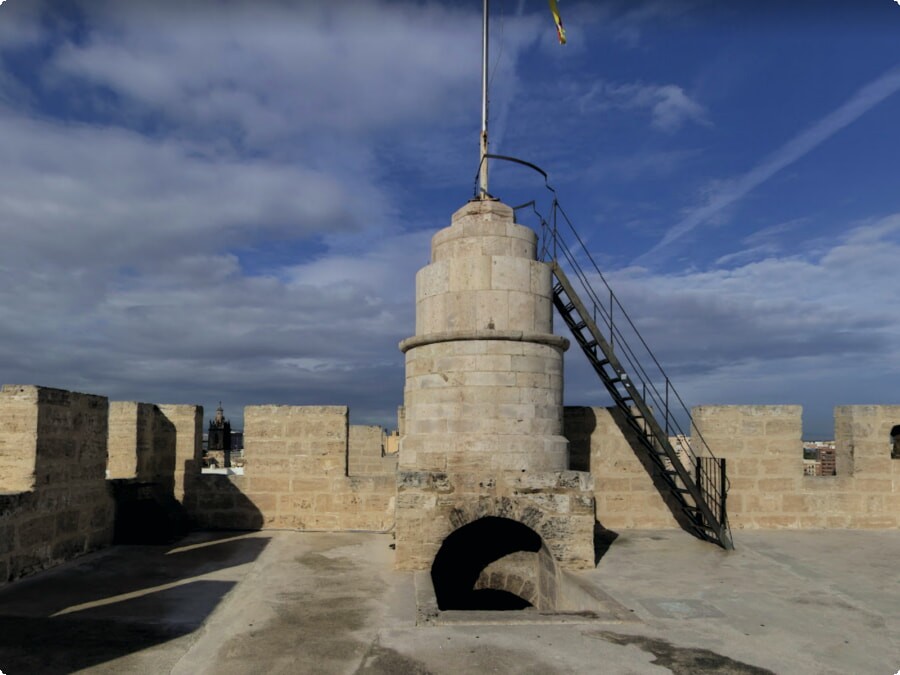1. City of Arts and Sciences
Located on the former riverbed of the Turia River, this complex of museums, art, theatres and an aquarium is a symbol of Valencia’s 21st century ambition. It aims to influence scientific, cultural, leisure, tourist and economic urban development. It is a place for everyone and an example of how the city embraces its past whilst looking to the future with confidence.
The City of Arts and Sciences was designed by the renowned Spanish architect Santiago Calatrava. It’s a must-visit for anyone who wants to see Valencia from a completely different angle. It is also one of the most popular places to visit in the city. The summer months are a great time to experience the City of Arts and Sciences. Not only is the architecture magnificent but there are plenty of exciting exhibitions and films to choose from.
The l’Hemisferic, which looks like an eye open to the world, houses an IMAX cinema and planetarium. Other buildings include the Museu de les Ciencies Principe Felipe – an interactive science museum that looks like a whale skeleton, and the opulent Palau de les Arts Reina Sofia opera house and arts center. The highest point of the complex is the 123 meter high Assut de l’Or Bridge, which was modeled on two entwined hands and covered with blue trencadis.
The best way to explore the City of Arts and Sciences is by joining a guided tour. The expert guides will tell you all about the city’s history and point out the highlights of each building. They can also suggest other attractions that you may not have heard of or might have overlooked! A walk around the historic district is another way to get a feel for Valencia’s rich culture. Here, you’ll discover some of the city’s oldest buildings rubbing shoulders with modern and colorful street art.
It is impossible to get acquainted with the sights of Spain in one day, as well as in a week, but you can see the maximum number of new places with the help of a rented car at one of the country's airports. For example, in Valencia you can rent a car from 17 euros per day, in Tenerife - from 18 euros per day.

2. Toria Park
Turia Park is one of Valencia’s most intriguing attractions. Created from the riverbed that heavily flooded the city in 1957, the park is a fascinating modern example of how landscape infrastructure can transform urban spaces and connect communities.
The park is an urban garden, complete with leisure areas, fountains, footpaths, bike lanes and open-air gyms. It connects Cabecera Park in the west, the City of Arts and Sciences in the north and the seaside neighborhood of Penya-Roja in the east. Nine kilometers of paths meander past ancient walls, sculpted gardens and a variety of architectural styles. There are also ponds where you can rent small swan-shaped boats, and the huge esplanades outside the Palau de la Musica host year-round concerts.
There are also plenty of activities for families to enjoy together, including biking and skating on the long, flat paths. You will see lots of people on segways and tandem bicycles whizzing by. The park is also home to a giant children’s playground called Snow White. The whole park is themed around the fairy tale and kids will love swinging, rotating wheels and sliding in tubes.
You’ll also find a giant juggler, a statue of Gulliver tied down by the Lilliputians and an Instagram-worthy bridge covered in flower pots. And of course, the park is filled with joggers. There are so many joggers in the park, at times it seems like they’re all some kind of weird cult or jog-zombies. It might be a bit of a shock to come from a country where jogging is not popular, but in Valencia it is a way of life. And it’s probably helping to extend the city’s residents’ lifespans.

3. Beaches
Valencia’s beaches — known as playas or platges in Spanish — are one of the city’s most dazzling natural attractions. From bustling stretches bursting with sun worshippers to calmer shores lined by rocky bays, there are beaches for every mood.
Pinedo Beach
Just north of the city, this gorgeous Blue Flag expanse is a nature lover’s dream, featuring dunes, protected fauna, and stunning views over the city skyline. Plus, it’s one of the only beaches in Valencia where dogs are allowed and has a nudist section (just to the right as you walk through the main path).
Alternatively, head to nearby La Devesa, also within the first transport catchment zone and easily accessible by bus 25. This huge sandy beach is a top pick for families and has everything you need for a day of blissful relaxation, from hammocks and sun loungers to showers and a scattering of restaurants. It’s also a good option for those with limited mobility, and has a large wheelchair-accessible area.
Another great option is Playa del Cabanyal, a popular spot for locals to disconnect and soak up the sun, with kilometres of fine sandy coastline to choose from. Here, you’ll find all sorts of facilities, including beach bars, gastronomic options, Red Cross safety hubs, and more. It’s a great place to try some traditional Valencian horchata too! It’s also a short stroll to the lovely, neighbouring La Albufera Natural Park, where you can explore wetlands and spot wildlife on foot or by boat.

4. Tapas
While the idea of tapas is more closely associated with Madrid and Barcelona, valencianos have also adopted this lovely tradition. And there are many excellent bars in the city where you can sample a wide range of local recipes.
You might start your evening with the classic patatas bravas, a dish made of unskinned potatoes cut in small pieces and fried to golden perfection. The traditional recipe is usually seasoned with salt and pepper, but you can add some garlic or chili for an extra kick.
Another great option is a plate of pimientos de padron, a local specialty that features small green peppers fried in olive oil and sprinkled with coarse sea salt. Some of these peppers are mild, while others pack a punch of heat. These tasty morsels are best enjoyed at a tiny, local bar where the atmosphere is as simple as the food – strip lighting and a few bar stools.
Other traditional Valencian dishes that you might want to try include batter-fried calamari and esgarraet, a dish consisting of shredded salt cod marinated in a zesty blend of olive oil, garlic, lemon juice, and chopped roasted red peppers. The resulting flavor symphony is best eaten with a piece of bread.
If you want to try something different from traditional Valencian cuisine, you can head to a place like Ostrabar, where chef Quique Dacosta serves up a variety of unique dishes. The ambiance is casual and inviting, and the service is friendly and attentive. In addition to serving some of the most popular tapas in the city, Ostrabar has a wide selection of wines and cavas, as well as cured meats, cheese boards, and montaditos (mini sandwiches).

5. Horchatta
The beverage of choice during the winter and summer, horchata (also known as orxata in Valencian) is one of the region’s most famous non-alcoholic beverages. Made from ground chufa nuts (also known as tiger nuts), this drink is often served ice cold. Although horchata is sometimes confused with Mexican horchata, which uses rice, the Spanish version has roots in Valencian culture that date back to the 13th century.
The drink is sweet and refreshing, with a similar texture to milk. It can be served as a liquid, frappe, or mixed into food such as a smoothie or ice cream. The chufa nuts are grown locally and are considered a speciality product of the region, and have been awarded a Denomination of Origin status. They are rich in fibre and a good source of iron. They are also known to help regulate the intestinal flow and are believed to be one of the reasons why Valencia’s inhabitants have some of the highest life expectancy rates in the world!
During the spring and summer, it is not uncommon to see families sitting outside of a local horchateria enjoying a chilled glass. It is a popular drink for all ages.
The best places to try horchata in Valencia are the traditional family-owned businesses that have built their business on legacy and quality. L’Obrador de Bou is a great example of how this type of approach can lead to a memorable experience for visitors to the city. Located near the city centre and Mercado Central, they offer a cosy atmosphere and serve their delicious drinks with fartons – crunchy biscuits that are perfect for pairing with a glass of horchata.